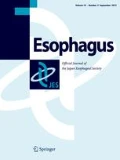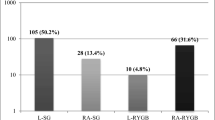Abstract
Background
In spite of appropriate preparation, food residue that interferes with endoscopic examination is occasionally observed in an operated stomach. The present study aimed to elucidate the incidence of such food residue and determine its risk factors in gastric pull-up after esophagectomy.
Methods
A total of 116 esophagectomized patients underwent the first postoperative endoscopy to survey their gastric pull-up with a median interval of 14 months (range 6–24) after the surgery. Fasting time was 13–16 h before the examination. The amount of food residue was retrospectively classified from Grade 0 (no food residue) to Grade 4 (a large amount of food residue) by two expert endoscopists.
Results
Among the 116 patients, 73 patients were classified as Grade 0, 23 patients as Grade 1, 10 patients as Grade 2, 9 patients as Grade 3, and 1 patient as Grade 4. Food residue (≥Grade 2) that interfered with the examination was observed in 20 patients (17.2 %). There was no significant association between the food residue and patient baseline characteristics.
Conclusion
The food residue interfering with postoperative endoscopic examination was observed in 17.2 % of all surveyed gastric pull-ups.


Similar content being viewed by others
References
Jemal A, Bray F, Center MM, et al. Global cancer statistics. CA Cancer J Clin. 2011;61:69–90.
Ando N, Ozawa S, Kitagawa Y, et al. Improvement in the results of surgical treatment of advanced squamous esophageal carcinoma during 15 consecutive years. Ann Surg. 2000;232:225–32.
Ozawa S, Tachimori Y, Baba H, et al. Comprehensive registry of esophageal cancer in Japan, 2004. Esophagus. 2012;9:75–98.
Okamoto N, Ozawa S, Kitagawa Y, et al. Metachronous gastric carcinoma from a gastric tube after radical surgery for esophageal carcinoma. Ann Thorac Surg. 2004;77:1189–92.
Sugiura T, Kato H, Tachimori Y, et al. Second primary carcinoma in the gastric tube constructed as an esophageal substitute after esophagectomy. J Am Coll Surg. 2002;194:578–83.
Jablonski S, Piskorz L, Wawrzycki M. Gastric tube resection due to metachronic cancer and a recurrence in anastomosis after Ivor-Lewis esophagectomy—case report. World J Surg Oncol. 2012;10:83.
Ikeda Y, Tobari S, Niimi M, et al. Second primary double carcinomas of the residual cervical esophagus and the gastric tube after thoracic esophagectomy. J Thorac Cardiovasc Surg. 2003;125:1561–2.
Nonaka S, Oda I, Sato C, et al. Endoscopic submucosal dissection for gastric tube cancer after esophagectomy. Gastrointest Endosc. 2014;79:260–70.
Oki E, Morita M, Toh Y, et al. Gastric cancer in the reconstructed gastric tube after radical esophagectomy: a single-center experience. Surg Today. 2011;41:966–9.
Cho SB, Yoon KW, Park SY, et al. Risk factors for food residue after distal gastrectomy and a new effective preparation for endoscopy: the water-intake method. Gut Liver. 2009;3:186–91.
Ahn JY, Jung HY, Bae SE, et al. Proper preparation to reduce endoscopic reexamination due to food residue after distal gastrectomy for gastric cancer. Surg Endosc. 2013;27:910–7.
Nakabayashi T, Mochiki E, Garcia M, et al. Gastropyloric motor activity and the effects of erythromycin given orally after esophagectomy. Am J Surg. 2002;183:317–23.
Kubo M, Sasako M, Gotoda T, et al. Endoscopic evaluation of the remnant stomach after gastrectomy: proposal for a new classification. Gastric Cancer. 2002;5:83–9.
Jung HJ, Lee JH, Ryu KW, et al. The influence of reconstruction methods on food retention phenomenon in the remnant stomach after a subtotal gastrectomy. J Surg Oncol. 2008;98:11–4.
Nozaki I, Hato S, Yamashita M, et al. Hand-sewn anastomotic technique after esophageal cancer resection. Hepatogastroenterology. 2014;61:1957–60.
Law S, Fok M, Chu KM, et al. Comparison of hand-sewn and stapled esophagogastric anastomosis after esophageal resection for cancer: a prospective randomized controlled trial. Ann Surg. 1997;226:169–73.
Mukaide H, Inoue K, Fukui J, et al. Water for the preparation of upper gastrointestinal endoscopy after gastrectomy. Gan Kagaku Ryoho. 2014;40:609–12.
Akkerman RD, Haverkamp L, van Hillegersberg R, et al. Surgical techniques to prevent delayed gastric emptying after esophagectomy with gastric interposition: a systematic review. Ann Thorac Surg. 2014;98:1512–9.
Lee HS, Kim MS, Lee JM, et al. Intrathoracic gastric emptying of solid food after esophagectomy for esophageal cancer. Ann Thorac Surg. 2005;80:443–7.
Wormald JC, Bennett J, van Leuven M, et al. Does the site of anastomosis for esophagectomy affect long-term quality of life? Dis Esophagus. 2014. doi:10.1111/dote.12301.
Schmidt CE, Bestmann B, Kuchler T, et al. Quality of life associated with surgery for esophageal cancer: differences between collar and intrathoracic anastomoses. World J Surg. 2004;28:355–60.
Kim HK, Choi YH, Shim JH, et al. Endoscopic evaluation of the quality of the anastomosis after esophagectomy with gastric tube reconstruction. World J Surg. 2008;32:2010–4.
Izbeki F, Wittmann T, Odor S, et al. Synchronous electrogastrographic and manometric study of the stomach as an esophageal substitute. World J Gastroenterol. 2005;11:1172–8.
Acknowledgments
This research is supported by the Practical Research for Innovative Cancer Control from Japan Agency for Medical Research and development, AMED.
Author information
Authors and Affiliations
Corresponding author
Ethics declarations
Ethical Statement
All procedures followed were in accordance with the ethical standards of the responsible committee on human experimentation (institutional and national) and with the Helsinki Declaration of 1964 and later versions. We have protected the privacy of the patient, and the manuscript does not include any identifying information. The present study was approved by the local ethics committee at the Shikoku Cancer Center.
Conflict of interest
Drs. Isao Nozaki, Shinji Hato, Shinichirou Hori, Norifumi Nishide, and Akira Kurita declare that they have no conflicts of interest.
Rights and permissions
About this article
Cite this article
Nozaki, I., Hato, S., Hori, S. et al. Incidence of food residue interfering with postoperative endoscopic examination for gastric pull-up after esophagectomy. Esophagus 13, 195–199 (2016). https://doi.org/10.1007/s10388-015-0516-2
Received:
Accepted:
Published:
Issue Date:
DOI: https://doi.org/10.1007/s10388-015-0516-2




